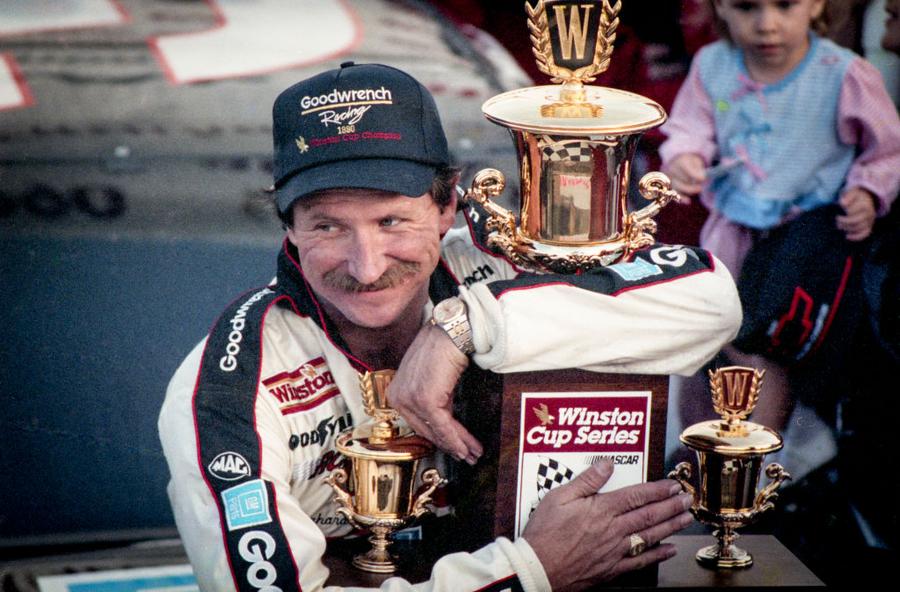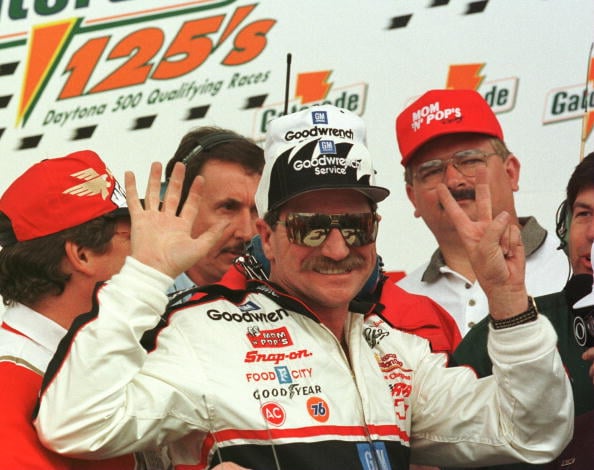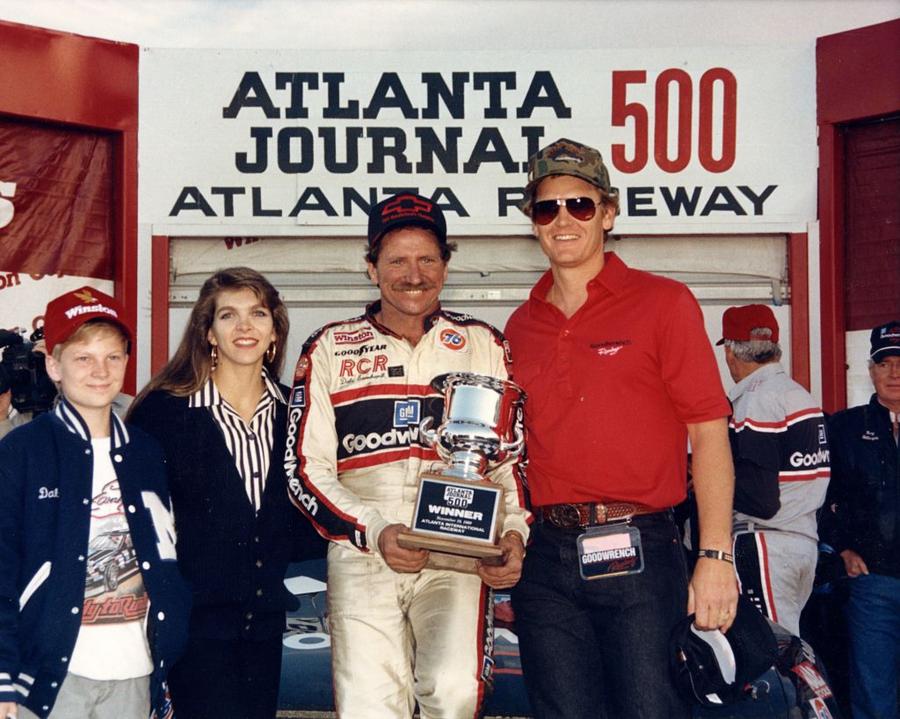What Was Dale Earnhardt Sr.'s Net Worth?
Dale Earnhardt Sr. was a racecar driver and team owner who had a net worth of $70 million at the time of his death in 2001. Dale Earnhardt raced from 1975 to 2001 in the NASCAR Cup Series. Over the course of his career, he won a total of 76 Cup races and earned seven Cup championships. In 2001, Earnhardt was killed in a last-lap crash during the Daytona 500, leading to safety improvements in future car racing events.
His son Dale Earnhardt Jr. is one of the most successful NASCAR drivers of all time. At his peak, Dale Jr. earned over $20 million every year. He has a net worth of $300 million.
Early Life and Career Beginnings
Ralph Dale Earnhardt was born on April 29, 1951, in Kannapolis, North Carolina. He was the third child of Martha and Ralph Earnhardt. His father, who was a top short-track driver in the state, won the NASCAR Sportsman Championship in 1956. At the age of 12, Earnhardt covertly drove his father's car in one of his races. Despite his father's protests, Dale dropped out of school to pursue his career as a race car driver. Tragedy struck in 1973 when his father passed away from a heart attack.
Earnhardt started his professional career in 1975 at the NASCAR Winston Cup Series and competed in eight more races up until 1979.
Early NASCAR Career Successes
In 1979, Earnhardt joined Rod Osterlund Racing; in his rookie season, he won a race at Bristol, scored 11 top fives and 17 top tens, and finished seventh in the points standings. As a result, he was honored as Rookie of the Year. The next season, Dale won a number of races, including the Busch Clash, and had his first Winston Cup Championship victory. In the process, he became the only driver in NASCAR history to follow a Rookie of the Year title with a NASCAR Cup Championship the very next year.
Earnhardt left Rod Osterlund Racing in 1981 and joined Bud Moore Engineering for two years. He struggled in 1982 but won at Nashville and Talladega in 1983. Following this, Dale returned to Richard Childress Racing, winning numerous races. In 1986, he won his second Winston Cup Championship; the next year, he successfully defended his title by winning over Bill Elliott by 489 points.

(Photo by Brian Cleary/Getty Images)
NASCAR in the '90s
Beginning the 1990 season, Earnhardt won both the Busch Clash and his heat of the Gatorade Twin 125s. He went on to finish with nine race victories and a fourth Winston Cup title. In 1991, he once again defended his title by winning another Winston Cup. The next season was less successful, as Dale scored only one win, in the Coca-Cola 600. Later, in 1994, he came roaring back with another Winston Cup Championship title, winning over Mark Martin by more than 400 points. Although Earnhardt was unable to win the Championship again the next year, he still emerged victorious at five races, including the Brickyard 400 at Indianapolis Motor Speedway, a win he has called the biggest of his career.
In 1996, a major crash at the DieHard 500 saw Earnhardt's car hit the wall head-on at nearly 200 mph, causing it to flip and slide across the track. This and a previous, similar incident led to NASCAR mandating the "Earnhardt Bar," a metal reinforcing brace in the center of the windshield. Although he suffered a broken collarbone, shoulder blade, and sternum, Dale continued to race over the following weeks, finishing fourth in the standings for the season. In 1998, he had one of his greatest victories when he finally won the Daytona 500 on his 20th attempt. The next year, he swept Talladega and had a controversial win at the Bristol night race, during which he accidentally bumped into and spun the car of leader Terry Labonte.

Getty Images
Final Racing Years and Death
Earnhardt experienced two of his most exciting races in 2000, first winning by only 0.010 seconds in Atlanta and then gaining 17 positions in the final four laps to emerge victorious at Talladega. However, he was ultimately unable to win another championship title. Tragically, the 2001 season was the last for Earnhardt. On February 18, 2001, at the Daytona 500, he was killed in a three-car crash during the final lap of the race. His car collided with Ken Schrader's, both sliding off the track and banking into the infield grass.
In the aftermath of the tragedy, NASCAR implemented more rigorous safety protocols, including the mandating of a head restraint known as HANS. Earnhardt's remains are interred at his estate in Mooresville, North Carolina.

(Photo by ISC Archives/CQ-Roll Call Group via Getty Images)
Personal Life
At the age of 17 in 1968, Dale married his first wife, Latane Brown; together, they had a son, Kerry, and divorced in 1970. The next year, Earnhardt wed Brenda Gee, the daughter of car builder Robert Gee. The couple had two children, Kelley and Dale Jr., and divorced in 1974. In 1982, Earnhardt married his third and final wife, Teresa Houston, who is known today as Teresa Earnhardt. Their daughter, Taylor, was born in 1988.
Legacy
Earnhardt continues to exert a lasting legacy. Several roads are named after him in his home state of North Carolina as well as in Texas. In 2002, he was posthumously inducted into the Motorsports Hall of Fame of America, and in 2006, he was inducted into the International Motorsports Hall of Fame. The following year, the Dale Earnhardt Foundation and Dale Earnhardt, Inc. partnered to fund an annual undergraduate scholarship at Clemson University for students involved in automotive engineering and motorsports.
In 2010, the Intimidator 305 roller coaster, named after Earnhardt, opened at the Kings Dominion amusement park in Doswell, Virginia. The coaster's trains are modeled after Dale's iconic black-and-red Chevrolet.
Real Estate
Earnhardt Farm – Mooresville, NC
Earnhardt Farm, the sprawling 399-acre property in Mooresville, North Carolina, remains under the control of Teresa Earnhardt. This estate, once Dale Earnhardt Sr.'s personal retreat, includes his custom log mansion, hunting grounds, garages, and a private family mausoleum where he is laid to rest. In 2024, Teresa attempted to rezone the land for industrial development, proposing the Mooresville Technology Park. However, local opposition and community backlash led to the town's Planning Board rejecting the request. The final decision rests with the Mooresville Board of Commissioners, and as of early 2025, the property remains in the Earnhardt family's hands, undeveloped.
Palm Beach Gardens Home – Palm Beach County, FL
Dale also owned a luxury waterfront home in Palm Beach Gardens, Florida, which served as his vacation retreat and boating haven. The 5,268 sq. ft. residence featured direct water access, a private dock, and housed his yacht "Sunday Money." Teresa retained ownership for nearly two decades before selling it in 2021 for $4 million to Clarke and Jessica MacArthur. The new owners renovated the home extensively, modernizing the interiors and enhancing its luxury appeal. Since then, the property's value has significantly increased, with estimates placing it between $6 to $8 million.
/2021/07/Dale-Earnhardt.jpg)
/2010/09/dw.jpg)
/2009/10/Dale-Earnhardt-Jr.jpg)
/2014/10/dale.jpg)
/2020/03/jeff-gordon.jpg)
/2012/09/Teresa-Earnhardt.jpg)
/2009/09/Brad-Pitt.jpg)
/2017/02/GettyImages-528215436.jpg)
/2019/10/denzel-washington-1.jpg)
/2009/09/Cristiano-Ronaldo.jpg)
/2009/11/George-Clooney.jpg)
/2020/06/taylor.png)
/2018/03/GettyImages-821622848.jpg)
/2009/09/Jennifer-Aniston.jpg)
/2020/02/Angelina-Jolie.png)
/2020/01/lopez3.jpg)
/2019/11/GettyImages-1094653148.jpg)
/2021/07/Dale-Earnhardt.jpg)
/2020/03/jeff-gordon.jpg)
/2009/10/Dale-Earnhardt-Jr.jpg)
/2010/09/dw.jpg)
/2019/11/jimmie.jpg)
/2010/05/Michael-Waltrip.jpg)
/2010/05/Rick-Hendrick.jpg)
/2019/04/rr.jpg)
:strip_exif()/2009/09/P-Diddy.jpg)
:strip_exif()/2015/09/GettyImages-476575299.jpg)